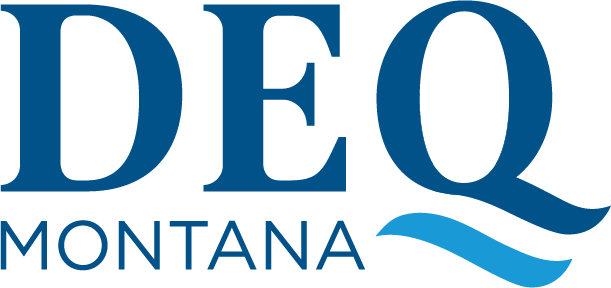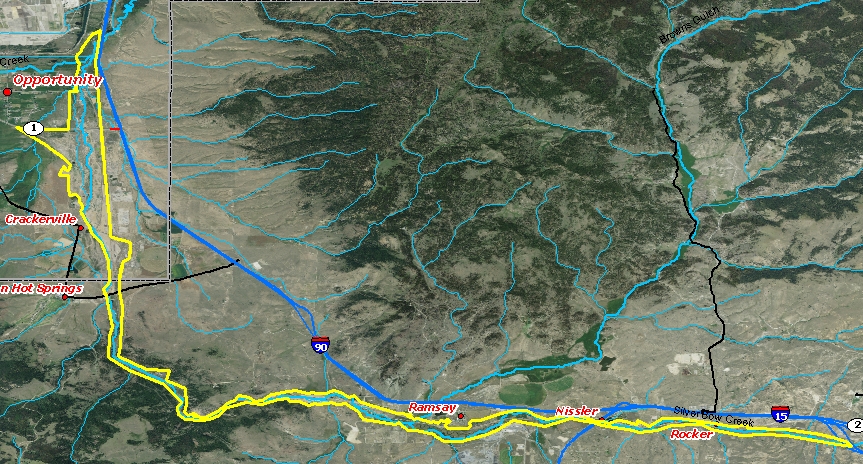Program Overview
Federal National Priority List (NPL) Site Map
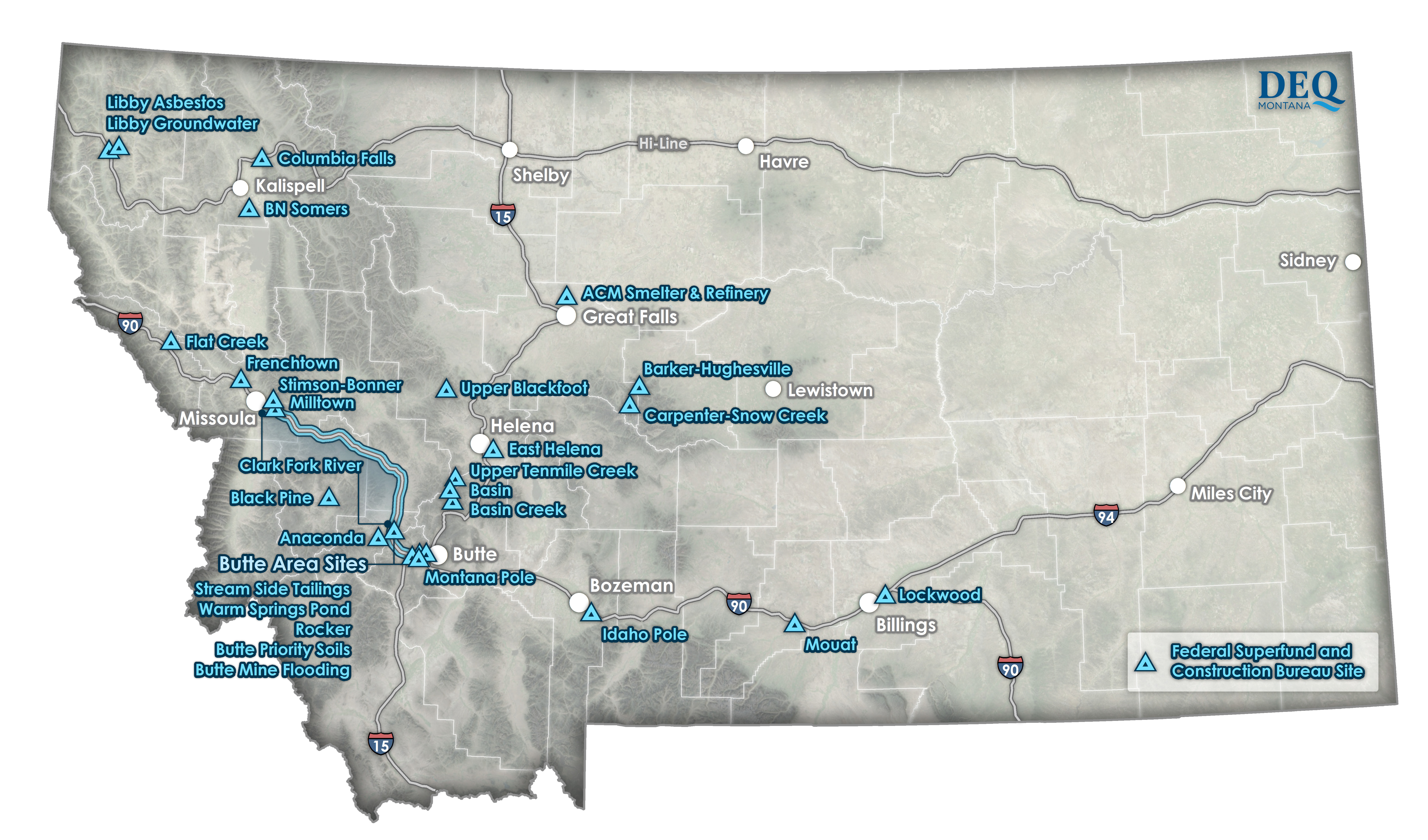
The Federal Superfund and Construction Bureau consults with Environmental Protection Agency (EPA) Region 8 on National Priorities List (NPL) sites and is typically the support agency overseeing the implementation of the remedial process. We provide technical and management assistance to EPA to support the remedial actions and agency decisions at NPL sites and work cooperatively with all other agency partners, local stakeholders and the public to keep them informed during the Superfund process. Montana DEQ’s activities are usually funded through cooperative agreements with EPA or settlement funds.
Federal Superfund Contacts
Main Number
(406) 444-6444
DEQ Program Support
Joann Wiggins (406) 444-6795
DEQ Federal Superfund Supervisor
Kevin Stone (406) 444-0214
List of Sites
The following is a list of sites that the Federal Superfund and Construction Bureau is currently working on. The final column is the Project Manager contact information for Montana DEQ Remediation. The Project Manager oversees the work being done alongside the EPA. The second table contains information about the Black Pine Mining Site, the Stimson-Bonner Mill Site, and the Upper Blackfoot Mining Complex, all of which are non-NPL sites but are under the Construction portion of the Bureau.
| Site Name | Short Name | Site Location | CERCLA/EPA ID | Lead | DEQ Project Manager |
|---|---|---|---|---|---|
| ACM Smelter & Refinery NPC | ACMSRNPC | Great Falls | MTD093291599 | EPA | Dick Sloan |
| Anaconda Smelter Site | ACSS | Anaconda | MTD093291656 | EPA | Amber Nichols |
| Barker Hughesville Mining District | BHMD | Monarch | MTD612230748 | EPA | Amber Nichols |
| Basin Creek Mine | BCM | Basin | MTD982572562 | MT DEQ | Logan Dudding |
| Basin Mining Area | BMA | Basin | MTD982572562 | EPA | Dick Sloan |
| Blacktail Creek | BTC | Butte | MTD980502777 | MT DEQ | Alyx Ruzevich |
| Burlington Northern Somers | BNS | Somers | Non-NPL Site | EPA | Dick Sloan |
| Butte Mine Flooding | BMF | Butte | MTD980502777 | EPA | Daryl Reed |
| Butte Priority Soils | BPS | Butte | MTD980502777 | EPA | Daryl Reed |
| Carpenter-Snow Creek Mining District | CSCMD | Neihart | MT0001096353 | EPA | Amber Nichols |
| Clark Fork River | CFR | Opportunity to Milltown | MTD980717565 | MT DEQ | Logan Dudding |
| Columbia Falls Aluminum Reduction Plant | CFAC | Columbia Falls | MTD057561763 | EPA | Dick Sloan |
| East Helena Smelter Site | EHS | East Helena | MTD006230346 | EPA | Jacob Wheeling |
| Flat Creek IMM Site | FCIMM | Superior | MT0012694970 | EPA | Daryl Reed |
| Frenchtown Mill (Smurfitt Stone) | Missoula | Pre-Listing | EPA | Breana Pabst | |
| Idaho Pole Co. | IDPC | Bozeman | MTD006232276 | EPA | Jacob Wheeling |
| Libby Asbestos | LA | Libby | MTD009083840 | EPA | Melody Wunderlin |
| Libby Ground Water Contamination | LGWC | Libby | MTD980502736 | EPA | Melody Wunderlin |
| Lockwood Solvent Groundwater Plume Site | LSGWP | Billings | MT0007623052 | EPA | Dick Sloan |
| Milltown Reservoir Sediments | MRS | Milltown | MTD980717565 | EPA | Breana Pabst |
| Montana Pole and Treating Plant | MTPOLE | Butte | MTD006230635 | MT DEQ | Jacob Wheeling |
| Mouat Industries | MI | Columbus | MTD021997689 | EPA | Daryl Reed |
| Rocker | ROCKER | Rocker | MTD980502777 | EPA | Daryl Reed |
| Silver Bow Creek/Butte Area Stream Side Tailings | SST | Butte-Anaconda | MTD980502777 | MT DEQ | Logan Dudding |
| Upper Tenmile Creek Mining Area | UTCMA | Helena, Rimini | MTSFN7578012 | EPA | Dick Sloan |
| Warm Springs Ponds | WSP | Warm Springs | MTD980502777 | EPA | Daryl Reed |
| Project Site Name | Short Name | Site Location | Program | MT DEQ Lead | Partners | FSB Project Manager |
|---|---|---|---|---|---|---|
| Black Pine Mine | BPM | Philipsburg | Construction Services | MT DEQ | USFS | Bob Flesher |
| Stimson-Bonner Mill PCB Site | SBM | Bonner | State Superfund | MT DEQ | EPA/MT NRD | Vacant |
| Upper Blackfoot Mining Complex | UBMC or Mike Horse | Lincoln | State Superfund | MT DEQ | USFS/MT NRD | Amber Nichols |
Specific Project Information
Blacktail Creek
Blacktail Creek is an urban stream located within Butte, MT. The creek originates in the Summit Valley, drains the Highland Mountains, and is a tributary to Silver Bow Creek. Blacktail Creek, along with the confluence with Silver Bow Creek, has been impacted by past industrial activities that disposed of mining, milling, smelting, and other wastes in the creek corridor. These depositions have led to an increased risk to human and environmental health.
With the signing of the amended record of decision for Butte Priority Soils Operable Unit, and the finalization of the enacting Consent Decree, the Montana Department of Environmental Quality, on behalf of the State of Montana, was assigned responsibility for implementing the BTC Riparian Actions and received a settlement of $20.5 million to successfully complete this project.
The major objectives of the remedial activities for the Blacktail Creek area, as outlined by the Consent Decree, are to:
- Remove tailings, wastes, contaminated soils and sediments from Blacktail Creek and Silver Bow Creek below the confluence with Blacktail Creek, including the Blacktail Creek wetlands;
- Control of discharge of contaminated groundwater to surface water in the project area (a responsibility of the settling defendants);
- Reconstruct Blacktail Creek and Silver Bow Creek Below the Confluence with Blacktail Creek;
- Revegetate all areas addressed in these actions in accordance with ARARs.
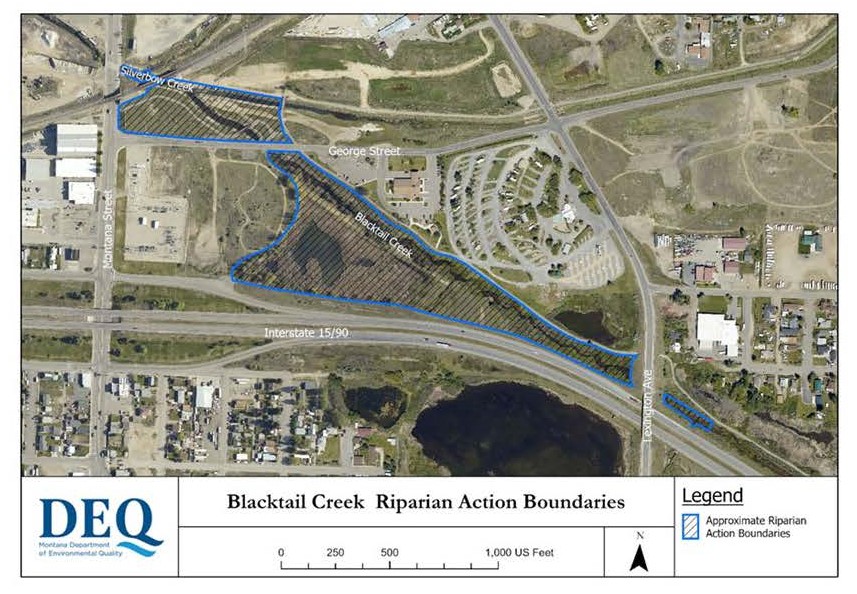
Currently, DEQ is in the pre-design investigation phase of the project. DEQ is working to investigate data gaps so that the project can move forward with the remedial design process. Making sure we have all the necessary data prior to moving forward with a design is a key step that ensures a science driven and cost-effective approach to meeting DEQ’s responsibilities in the Consent Decree.
Click to subscribe for email updates for the Blacktail Creek site: Email Updates
Pre-Design Investigation
Draft Blacktail Creek UFP QAPP
Consent Decree
Butte Priority Soils Consent Decree Appendix D BPSOU Statement of Work
Butte Priority Soils Consent Decree Appendix H Blacktail Creek Riparian Actions Outline
Past Studies
MBMG Stream Characterization of Blacktail and Silver Bow Creeks
Data Gap Investigation – Silver Bow Creek and Blacktail Creek Corridors
Fact Sheets
| Name | Position | Phone Number | |
|---|---|---|---|
| Jorri Dyer | Section Supervisor | jorri.dyer@mt.gov | (406) 444-6458 |
| Alyx Ruzevich | Project Officer | alyxandra.ruzevich@mt.gov | (406) 444-6802 |
Billings PCE
BPCE Vapor Intrusion (VI) Study Area is a shallow groundwater contaminant plume encompassing 855 acres and extends from the intersection of Industrial Avenue and Daniel Street in Billings, MT approximately three miles, east-northeast, through numerous mixed-use neighborhoods into downtown Billings. Contaminated groundwater is associated with releases of dry-cleaning chemicals and other industrial sources. The BPCE Site was added to the National Priorities List in the Federal Register in September 2021.
Multiple investigations and remedial actions have been conducted across the BPCE VI Study Area to assess groundwater quality and VI into structures above the COPC plume and are summarized below:
- 1993 – Montana Department of Environmental Quality (MDEQ) completed a preliminary assessment in which the MDEQ and EPA issued a “no further action” determination for the BPCE VI Study Area, given that the aquifer was not being used as a drinking water source at the time.
- 2001 – the MDEQ completed a site investigation and determined indoor air contaminant concentrations may exceed levels with the potential to cause health risks for building occupants (at structures overlying the groundwater plume).
- 2007 – EPA conducted a removal action involving the excavation and disposal of contaminated soil, injecting chemicals into groundwater to assist in the reduction of contamination, installing a non‑permeable barrier wall around the most contaminated groundwater, and installing vapor mitigation systems at seven structures overlying the plume.
- 2019 – MDEQ issued a RI Report that characterized the nature and extent of potential contaminates dissolved in groundwater known at the time. Multiple sources of potential contaminate were found. Surface and subsurface soil were determined to be leaching to groundwater and the VI pathway is complete at some structures.
- 2022 – EPA conducted a VI investigation including sampling of indoor air, crawlspace air, outdoor air, sub-slab vapor, and soil vapor in 48 structures in and near the BPCE VI Study Area.
- 2022 – EPA conducted a soil vapor and groundwater investigation including the installation and sampling of up to 103 temporary soil vapor points and 16 semi-permanent soil vapor points and sampling of 12 groundwater monitoring wells.
- 2022 – EPA conducted a utility corridor investigation including the sampling of 35 sanitary sewer manholes.
- 2022 – EPA conducted a VI investigation including sampling indoor air, crawlspace air, and sub-slab vapor in 112 structures.
- 2022 – EPA conducted a utility corridor investigation including the sampling of up to 58 sanitary sewer manholes.
Wondering whether your property is located within or near the Billings PCE study area? Use this web link to find out. https://arcg.is/0KyfvL1
| Name | Position | Phone Number | |
|---|---|---|---|
| Breana Pabst | DEQ Project Manager | Breana.Pabst@mt.gov | (406) 444-0215 |
| Nolan Lister | DEQ Public Information Specialist | nolan.lister@mt.gov | (406) 444-6469 |
| Roger Hoogerheide | EPA Project Manager | Hoogerheide.Roger@epa.gov | (406) 457-5031 |
Clark Fork River Operable Unit
Annual Monitoring Reports
Phase 7 Documents and Plans
Phase 7 Response to Design Review Team Comments
Phase 7 Data Summary Review Addendum
Phase 3 and 4 Documents and Plans
Phase 3 and 4 Draft Preliminary Design Report
Draft Data Summary Report May 2015
Phase 3 and 4 Appendix C, Part One
Phase 3 and 4 Appendix C, Part Two
Other Documents
Strategic Plan Response to Comments
Strategic Plan with Appendices October 2023
2017 Community Involvement Plan- Summary
2017 Community Involvement Plan- Full Document
2010 to 2017 Weed Control Summary Report
Explanation of Significant Difference June 2015
2008 Clark Fork River Consent Decree
2004 Record of Decision
Part 3: Responsiveness Summary
Part 4: Acronyms, Abbreviations & References
Appendix A: Indentification & Description of Applicable or Relevant & Appropriate Requirements
Appendix B: Streambank Stabilization Design Consideration & Examples
Appendix C: BMPs & Riparian Management Plan Considerations
Appendix D: Weed Prevention & Management Planning Information
Appendix E: Grant-Kohrs Ranch National Historic Site
Appendix F: Concurrence Letter from the State of Montana
The heavy metals (Cadmium, Copper, Zinc, and Lead) and arsenic in the Clark Fork River are from historic mining, milling and smelting processes linked to the Anaconda Company operations in Butte and Anaconda. The majority of the cleanup will occur along a 43-mile stretch of the river from Warm Springs in Anaconda/Deer Lodge County downstream to Garrison in Powell County. This is known as “Reach A.”
The Clark Fork River Operable Unit (CFR OU) is part of the Milltown Reservoir/Clark Fork River Superfund Site. The CFR OU includes the Clark Fork River from its headwaters near Warm Springs Creek to Milltown Reservoir, just east of Missoula.The primary sources of contamination are tailings mixed with soil in the streambanks and historic floodplain. These sources threaten human health and animal and plant life. The 2004 Record of Decision describes the cleanup approach, or Selected Remedy. In addition to the ROD, the NRDP developed a Restoration Plan to expedite the recovery time for injured aquatic and terrestrial resources in and along the Clark Fork River. To the extent practicable, the Restoration Plan will be combined with the Remedy to maximize the use of resources. The 2004 Record of Decision describes the cleanup approach, or Selected Remedy.
In 2008, 25 years after the state sued the Atlantic Richfield Co. for damage to natural resources, a settlement was reached and a federal judge signed the consent decree. The state received $123 million from ARCO for cleanup and restoration of mining pollution in the Clark Fork River Operable Unit.
The Montana Department of Environmental Quality (DEQ) and Montana Department of Justice, Natural Resource Damage Program (NRDP), with additional oversight from the U.S. Environmental Protection Agency (EPA) and National Parks Service (NPS) (for cleanup activities at the Grant-Kohrs Ranch operated by NPS) work collaboratively to design the remediation and restoration work.
In addition to the ROD, the NRDP developed a Restoration Plan to expedite the recovery time for injured aquatic and terrestrial resources in and along the Clark Fork River. To the extent practicable, the Restoration Plan will be combined with the Remedy to maximize the use of resources.
Click to subscribe for email updates for the Clark Fork River site: Email Updates
| Name | Position | Phone Number | |
|---|---|---|---|
|
Logan Dudding |
DEQ Project Manager |
406-444-6407 |
|
|
Jessica Banaszak |
DEQ Project Manager |
406-444-4158 |
|
|
Nolan Lister |
Public Information Specialist |
406-444-6469 |
Libby Asbestos
Federal Superfund sites in and around Libby, Montana include the Libby Asbestos site and the Libby Groundwater site. The Libby Asbestos Site is located in Libby and Troy in Lincoln County (see figure below). In the early 1920s, the Zonolite Company began vermiculite ore mining operations in Libby. Vermiculite from the Libby mine, bought by W.R. Grace in 1963, was contaminated with a toxic and highly friable form of asbestos called tremolite-actinolite series asbestos (often called Libby Amphibole asbestos or “LA”). The site has been divided into eight Operable Units (OU), as shown in the table below, to facilitate addressing contamination issues.
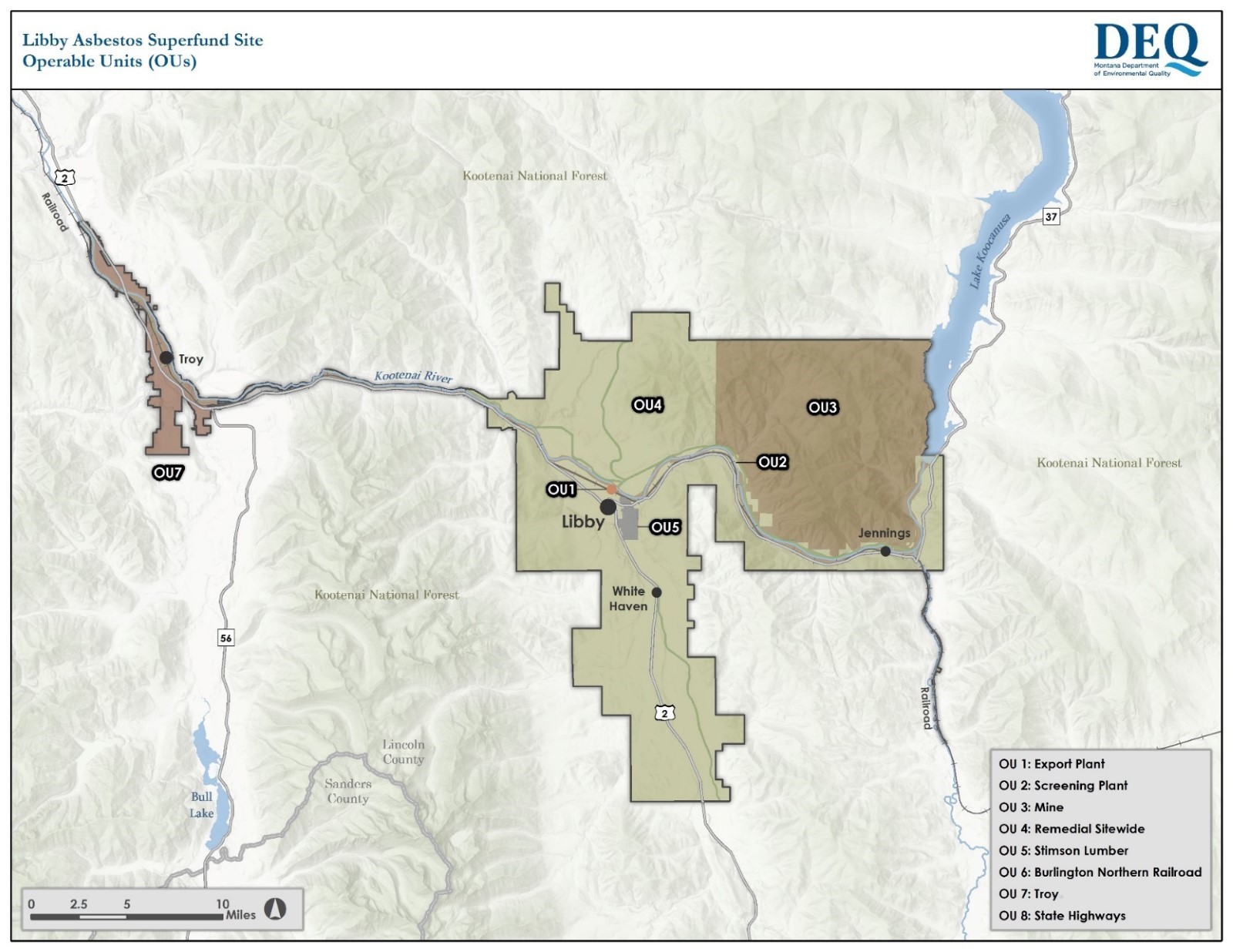
| Operable Unit | Description | Status |
|---|---|---|
|
OU1 |
Riverfront Part (former Export Plant) |
Remedial action complete. O&M ongoing. Partial deletion in 2020. |
|
OU2 |
Former Screening Plant |
Remedial action complete. O&M ongoing. Partial deletion in 2019. |
|
OU3 |
Former W.R. Grace Mine |
Remedial Investigation/Feasibility Study underway. |
|
OU4 |
Residential/Commercial properties in Libby |
Remedial Action Complete. O&M Ongoing |
|
OU5 |
Lincoln County Port Authority (former Stimson Lumber Mill) |
Remedial action complete. O&M ongoing. Partial Deletion 2024 |
|
OU6 |
BNSF Railroad Corridor |
Remedial Action Complete. O&M Ongoing. Partial Deletion 2022. |
|
OU7 |
Residential/commercial properties in Libby |
Remedial Action Complete. O&M Ongoing. |
|
OU8 |
Highways/Roadways |
Remedial Action Complete. O&M Ongoing. Partial Deletion 2021. |
Under Construction
About LASOC
In 2017, the 65th Montana Legislature passed Senate Bill 315, which was signed into law by Governor Bullock and established a Libby Asbestos Superfund Advisory Team attached to DEQ for administrative purposes. The Advisory Team was created to enhance communication with stakeholders. In addition, the Advisory Team advises DEQ on administration of the Libby Asbestos Cleanup Trust Fund and operation and maintenance accounts. The bill also established a full-time employee as the Libby Asbestos Superfund Liaison who will perform duties recommended by the team and facilitate the required quarterly Advisory Team meetings.
Subject to appropriation by the Legislature, money deposited in a state special revenue account must be used to fund cleanup and long-term operation and maintenance costs at the Libby Asbestos Superfund Site, and administrative costs of the Advisory Team and Libby Asbestos Superfund Liaison.
Libby Asbestos Superfund Oversight Committee Members
-
Commissioner, Brent Teske: (406) 283- 2317, bteske@libby.org
-
Director of the Department of Environmental Quality, Sonja Nowakowski: (406) 444-2544, sonja.nowakowski@mt.gov
-
Citizen of Lincoln County, George Jamison: (406) 293-8567, gjamison@libby.org
-
One member of the Montana House of Representatives, Rep. Tom Millett: (406) 212-3613, Tom.Millett@legmt.gov
-
One member of the Montana Senate, Sen. Mike Cuffe: (406) 293-1247 or (406) 889-5777, mcuffe@interbel.net and mike.cuffe@legmt.gov
Legislation
LASOC Final Bylaws Amended December 2021
Meeting Information from 2018-2022 can be requested through a DEQ Records Request
Oversight Committee Meeting Information
Access Code: 624-745-661
Agendas and Meeting Materials
October 30, 2025 Oversight Committee Meeting Agenda
- Draft August 29, 2025, Meeting Minutes
- LASOC Budget Report, September 30, 2025
- Draft LASOC O&M Support to Property Owners Report, October 2025
- BOH Letter to LASOC, October 14, 2025
- LASOC Facilitator Recommendation, October 2025
August 29, 2025 Oversight Committee Meeting Agenda
- Draft June 27, 2025, Meeting Minutes
- LASOC Budget Report July 2025
- Draft LASOC O&M Support to Property Owners Report, August 2025
- Draft Final LASOC Letter to EPA August 2025
- Potential Subcommittee Formation-Strawman
June 27, 2025 Oversight Committee Meeting Agenda
- Draft March 23, 2025, Meeting Minutes
- LASOC Budget Report May 2025
- Draft LASOC Letter June 2025
- Draft LASOC O&M Support to Property Owners Report, June 2025
- Pfau 2021 FWP PAS Libby Amphibole Ecological
- Pfau EPA Response to Five Year Review, November 2024
March 24, 2025 Oversight Committee Meeting Agenda
- LASOC Budget Report February 2025
- DRAFT LASOC O&M Support to Property Owners Report March 2025
- Draft December 9, 2024 Meeting Minutes
Meeting Minutes
August 29 2025 Meeting Minutes Approved
June 27, 2025 Meeting Minutes Approved
March 24, 2025 Meeting Minutes Approved
Meeting Memos
September 29, 2020 Interim Recommendations for LASOC
For More Information:
| Name | Position | Phone Number |
|---|---|---|
| Kevin Stone | Section Supervisor | (406) 444-0214 |
| Melody Kraayeveld | Project Officer | (406) 444-6456 |
| Nolan Lister | Public Information Specialist | (406) 444-6469 |
These links contain general asbestos information:
| Name | Position | Phone Number | |
|---|---|---|---|
|
Melody Kraayeveld |
DEQ Project Officer |
(406) 444-6456 |
|
|
Nolan Lister |
DEQ Public Information Specialist |
nolan.lister@mt.gov |
(406) 438-6469 |
|
Amanda Harcourt |
Lincoln County Asbestos Resource Program |
(406) 283-2445 |
|
|
Beth Archer |
EPA Community Involvement Coordinator |
(303) 312-6611 |
|
|
Dania Zinner |
EPA Remedial Project Manager |
(303) 312-7122 |
Montana Pole and Treating Plant
DEQ released the final Explanation of Significant Differences (ESD) for the Montana Pole. See documents section below for both the final ESD and responsiveness summary. The ESD proposes changes to the original cleanup plan to make the site more protective of human health and the environment. Now that the ESD is complete and approved by the Environmental Protection Agency (EPA), construction can begin this summer on the final cleanup for the south side of the site allowing for future redevelopment.
Construction for remediation cleanup will include placing the treated soils in an onsite designated capped area called a Corrective Action Management Unit (CAMU). The new cleanup levels will allow for commercial and industrial redevelopment for 27 acres of the site. The remaining 9 acres is the site of the CAMU, which will be comprised of the treated soils area and additional soils removed to achieve the new cleanup levels. The operation and maintenance of the CAMU will be overseen by the state to ensure protectiveness and will have regular Five Year Reviews. Five Year Reviews are a standard process required whenever contamination is safely left onsite. The reviews make sure the site remains protective.
Click to subscribe for email updates for the MT Pole site: Email Updates
Documents & Reports |
Date |
|---|---|
| Environmental Justice Plan | |
| EJSScreen Report | November 2021 |
| Dioxins and Protecting Your Health | April 2021 |
| Final Explanation of Significant Differences | March 2021 |
| Final Responsiveness Summary | March 2021 |
| Revised Final Baseline RA | 1993 |
5-Year Review |
Date |
| Fifth 5-Year Review | June 2022 |
| Fourth 5-Year Review | April 2017 |
Annual Reports |
Date |
| 2020 Final MPTP Annual Report | April 2021 |
| 2019 Final MPTP Annual Report | March 2020 |
Newsletters |
| February 2023 |
| Name | Position | Phone Number | |
|---|---|---|---|
|
Jacob Wheeling |
DEQ Project Manager |
(406) 444-6420 |
|
|
Allie Archer |
EPA Project Manager |
(406) 457-5033 |
|
|
Nolan Lister |
DEQ Public Information Specialist |
(406) 444-6469 |
Silver Bow Creek / Butte Area Stream Side Tailings
Interactive Story Map
The cleanup of Silver Bow Creek has been ongoing since 1999 as part of a Superfund remedial action being coordinated by the Montana Department of Environmental Quality (DEQ) in consultation with the U.S. Environmental Protection Agency (EPA). In 2000, the Natural Resource Damage Program (NRDP) of the Montana Department of Justice formed a partnership with DEQ, bringing a restoration component to the project that goes beyond remediation required under Superfund. Provided below is a brief history of the project, updates regarding the current status of the project, and descriptions of activities planned in future years.
Silver Bow Creek extends from Butte approximately 23 miles to the Warm Springs Ponds, a water treatment facility located at the headwaters of the Clark Fork River (see corridor map). Since the late 1800s, tailings and other mine wastes containing elevated concentrations of metals have been discharged to or otherwise entered Silver Bow Creek. These toxic discharges impacted the stream and floodplain with heavy metals and virtually eliminated aquatic life in the stream. Tailings deposited in the floodplain are toxic to plants and have resulted in a floodplain that is largely devoid of vegetation and is generally incapable of supporting wildlife. In 1983, EPA listed the Silver Bow Creek/Butte area as one of multiple Superfund sites in the Upper Clark Fork River Basin. The agency later designated the approximately 23 stream miles of streamside tailings along Silver Bow Creek as an operable unit (OU) within this overall Superfund site. The Streamside Tailings Operable Unit (SSTOU) has become one of the areas of focus for Superfund cleanup in the Butte area. Initially, EPA named ARCO as the primary party responsible for remediation of the SSTOU and other Superfund sites in the Upper Clark Fork Basin through its acquisition of the Anaconda Company. EPA and DEQ issued a Record of Decision (ROD) for the site in November 1995 that identifies the final site remedy and the agencies' rationale for selecting that remedy. The major remedial action that resulted from issuance of the ROD is excavation of tailings and related impacted soils from the floodplain of Silver Bow Creek and reconstruction of the stream channel and floodplain. For planning purposes, the SSTOU was divided into four subareas, each with a distinct geologic and geographic character.
The Natural Resources Damage Program (NRDP) Connection. In a 1999 state, federal and tribal settlement, ARCO agreed to pay $215 million to the State to resolve certain claims. From the settlement amount, $80 million plus interest was set aside for DEQ and EPA to implement the remedy for Silver Bow Creek. Some of the remaining amount is being used to enhance the cleanup of Silver Bow Creek through various habitat improvements and restoration actions. DEQ and EPA are coordinating the cleanup of the Silver Bow Creek remedy with NRDP.
After 16 years of cleanup, the Silver Bow Creek/Streamside Tailings cleanup reached completion in summer 2015.
Cleanup consisted of excavation of tailings (mine waste containing heavy metals) and related impacted soils from the floodplain of Silver Bow Creek, and the reconstruction of the stream channel and floodplain, and total revegetation. 5.8 million cubic yards of tailings were hauled, or enough to fill Grizzly Stadium to the brim 21 times. The contaminated waste was hauled to Opportunity Ponds. Approximately 1,550 acres along Silver Bow Creek have been remediated and restored.
Fish surveys show that populations of Westslope cutthroat, brook trout, sculpins, and suckers have reestablished in the creek. Shrub and tree planting activities have enhanced wildlife habitat, along with a DEQ-implemented weed management program. Sightings of over 100 bird species, including bald eagles, osprey, swans, blue heron, and sandhill crane are common in the floodplain and wetland areas, as well as deer, elk, moose, beaver, muskrats, and mink.
DEQ will implement a 'final pass' cleanup before subareas are transitioned into operations and maintenance status. The final pass will address very small deposits of remaining remnant tailings-impacted soils to improve and enhance the remediation as a whole.
| Documents and Reports Name | Date |
|---|---|
| Final Monitoring Report 2024 | July 2025 |
| Final Monitoring Report 2023 | June 2024 |
| Final Monitoring Report 2022 | July 2023 |
| Silver Bow Creek Overview Update Map | March 2012 |
| Restoration Economy | September 2009 |
| The Silver Bow Creek Greenway | |
| Corridor Map |

Osprey and its Fish Photo taken by Don MacGee. Summer of 2011 |

Young Angler, Rye Vincent Rye Vincent is holding an 18.5 inch cutthroat trout catch from Silver Bow Creek just below Miles Crossing bridge. Summer of 2010 |
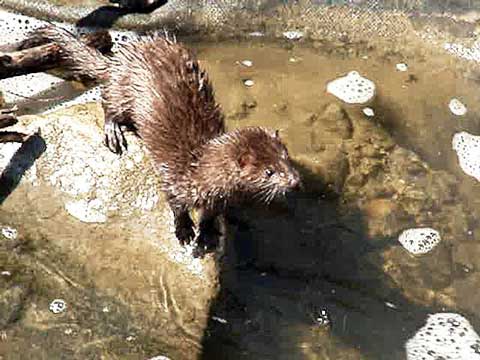
The Mink Return This mink was seen along Silver Bow Creek in September 2009. Mink prey on fish so the presence of mink indicates a return of fish to the stream. |
| Name | Position | Phone Number | |
|---|---|---|---|
|
Logan Dudding |
DEQ Project Officer |
(406) 444-6407 |
|
|
Emma Rott |
EPA Project Manager |
(406) 457-5003 |
Non-NPL Construction Sites
Black Pine Mine
The Black Pine Mine (BPM/Site) is an inactive silver mine located 10 miles northwest of Philipsburg in Granite County. The BPM complex includes 1,056 acres of patented mining claims and 150 unpatented lode claims. It is surrounded by lands administered by the US Forest Service. Approximately 400,000 CY of metals-impacted wastes are estimated to be present at, and down gradient of the Site. The impacted wastes include waste rock, tailings, and metals impacted soils and sediments.
The BPM is one of five sites in Montana that was owned and operated by ASARCO, until their bankruptcy filing in August 2005. In December 2009, $17.3 million was allocated to the BPM for environmental actions at the Site. DEQ was appointed as the lead agency for the reclamation. These funds are being managed by the Montana Environmental Trust Group, LLC (METG), Trustee for the Montana Environmental Custodial Trust.
DEQ performed a site characterization to investigate the nature and extent of contamination associated with mining and milling waste at the Site. Based on the results of the site characterization, reclamation alternatives are being evaluated to address human health and ecological risk.
Attention Contractors
To be considered during an invitation for bid, a contractor must meet several criteria, including but not limited to being bonded and insured, a registered contractor with the State of Montana and trained (40 hours) in emergency hazardous waste operations (HAZWOPER). The DEQ will develop designs for various stages of the work. When the design is complete, the project will be put out for construction bid on the DEQ website at www.deq.mt.gov. The DEQ will respond to questions and hold a pre-bid conference. Bids are sealed and opened at once in public. The DEQ selects the lowest responsible bidder.
| Document | Date |
|---|---|
| Site Cleanup Update | October 2017 |
| Final Conceptual Repository Design | August 2014 |
|
June 2014 |
|
| Draft Conceptual Repository Design Technical Memorandum | June 2014 |
| Repository Conceptual Design Plan Set | June 2014 |
|
December 2013 |
|
|
May 2012 |
|
|
August 2010 |
| Name | Position | Phone Number | |
|---|---|---|---|
|
Amy Schmechel |
DEQ Project Manager |
406-444-6436 |
|
|
Sonny Thornborrow |
Project Manager |
406-494-0202 |
Stimson-Bonner Mill PCB
The Bonner Mill Cooling Pond cleanup project is located in Bonner, Montana, along the Blackfoot River. In the early 1880s, the first logs were cut at the Bonner mill site and shipped to the mining operations in Butte. Over time, the Bonner mill site owners built and operated a “cooling pond,” which actually extended out into the Blackfoot River. In 2006, DEQ discovered contaminants (PCB) in the sediments of the cooling pond. The Department of Natural Resources & Conservation determined that because of the removal of the Bonner and Milltown dams immediately downstream from the cooling pond area, the berm of the cooling pond would fail during the next 100-year high flow flood, washing the PCBs downstream. Working with DEQ, Stimson Lumber entered into an Administrative Order of Consent in 2010 to remove the PCB contaminated areas threatening the Blackfoot River. Between September 2010 and April 2016, contaminated soils and debris was removed from the site and shipped to landills or an on-site repository; the river was restored and no longer does a threat from PCBs exist from areas it once did. This webpage provides links to public fact sheets and updates throughout the life of the project.
No public input received on a Draft Plan to Remove Wastes at the Bonner Mill Site Repository located in Missoula, MT
The Montana Department of Environmental Quality (DEQ) requested public input on a draft plan submitted by Bonner Property Development, the current landowner of the site, to remove waste at the Bonner Mill Site Repository and dispose of the waste at the Republic Landfill located in Missoula, MT. Currently, the repository is performing as designed and remains protective of human health and the environment. DEQ is not requiring any party to remove or alter the repository. DEQ has not approved any amendment or modification to the current restrictive covenants at the site. Public input was accepted until 5:00 p.m. on October 9, 2020. DEQ received no public input.
With the close of a request for public input, DEQ is currently reviewing the plan. DEQ’s review of the submitted draft plan will ensure that the proposed work will not conflict with ongoing work at the facility and that the work conducted will not spread, worsen, or otherwise exacerbate the PCB contamination. DEQ will review the plan to guarantee that all other relevant factors are considered for protectiveness of human health and the environment and that wastes are disposed of in a permitted landfill. If appropriate after such on-going review, DEQ may require revisions and additional information or approve a detailed work plan outlining the proposed work.
The draft plan documents are part of the administrative record. Site documents may be requested here: https://montanadeq.govqa.us/WEBAPP/_rs/(S(iv3hbh02ft3pfjbr2m144mfq))/supporthome.aspx
Documents and Reports |
|---|
| Bonner Progress Report August - September 2020 |
| Bonner Progress Report July - August 2020 |
| Name | Position | Phone Number | |
|---|---|---|---|
|
Vacant |
DEQ Project Manager |
|
406-444-6569 |
|
Nolan Lister |
Public Information Specialist |
406-444-6469 |
Upper Blackfoot Mining Complex
The Upper Blackfoot Mining Complex (UBMC) is a state superfund facility located about 15 miles east of Lincoln. Seeps from the tailings and waste rock dumps along with acid mine drainage from old adits have contaminated surface water, sediments, soils and groundwater. Additional contamination exists due to the 1975 dam failure that washed metals-laden tailings down the Beartrap Creek drainage and into the upper Blackfoot River.
DEQ has led cleanup efforts in coordination with the United States Forest Service (USFS) and Montana Natural Resource Damage Program (NRDP) over the past several years. The primary goal of the cleanup is to remove approximately 1 million cubic yards of tailings and mine waste to protect human health and the environment. This protection will be accomplished by minimizing direct contact with contaminants and limiting migration and mobility of contaminants within the environment.
Reclamation Nears Completion on Upper Blackfoot Mining Complex in Lewis & Clark County
Reclamation work is nearing completion at the Upper Blackfoot Mining Complex (UBMC), a State Superfund site located in Lewis & Clark County east of Lincoln, Mont.
The reclamation work has been a coordinated effort of the Department of Environmental Quality (DEQ), Department of Justice – Natural Resource Damage Program (NRDP) and United States Forest Service (Forest Service).
Historical mining practices contaminated the floodplains and waterways downstream of the Mike Horse Dam. The dam was built in 1941 to contain mine tailings but failed in 1975, flushing more than 200,000 cubic yards of mine tailings downstream for almost 10 miles and into the Blackfoot River. Required restoration and reclamation work included removal of the tailings dam and contaminated floodplain waste, as well as stream channel construction and floodplain restoration.
The cleanup removed approximately 1 million cubic yards of tailings and mine waste that had contaminated streams and the adjacent floodplains and made survival difficult for aquatic life, including fish. The contaminated material was removed from the banks and floodplain of the Blackfoot River and its tributaries, and encapsulated in a nearby repository. Water quality has returned to healthy levels following the reclamation and restoration of the site.
“This site is a great example of agencies working together to clean up pollution left by historic mining,” said Project Officer Dave Bowers from DEQ. “This unique piece of Montana can now be used by everyone to enjoy the clean river, trails and wildlife. Most importantly, the site is protective of human health and the environment.”
Restoration was completed on Mike Horse Creek, Beartrap Creek and Blackfoot River stream channels and adjacent floodplains. Fish are already populating the newly constructed stream channels.
“Seeing the restored streams teeming with life as clean, cold water flows from high on the continental divide is something we can all be proud of,” said Restoration Project Manager Beau Downing from NRDP. “I believe I speak for everyone involved with the project in saying that the outcome has far exceeded our expectations. Working with DEQ, the USFS, our project partners, and the contractors to complete the project has been a highlight of my career.”
Funding for the cleanup came from a $39 million settlement with Atlantic Richfield Co. and ASARCO, LLC—companies that came to own much of the historic mining district.
While a majority of the work is done, DEQ and the Forest Service may still have work to do in the areas outside the floodplains depending on the availability of alternative funding sources. Smaller areas disturbed by past exploration and mining practices were identified in the Record of Decision and need to undergo “design level” investigations. These investigations will determine the exact actions, if any, that need to be taken at each site. Depending on the outcomes of the investigations, possible actions could range from no action at all to complete removal.
“The work completed at the site is a true demonstration of multiple agencies working cooperatively together for the betterment of the environment in Montana,” said Steve Opp, on-scene coordinator for the Helena-Lewis and Clark National Forest. “The project partners have committed to long-term monitoring of the site that will last several years to measure the effectiveness of the clean-up and restoration.”
The site is now open for recreational use. The nonprofit Blackfoot Challenge is working on a self-guided tour that will feature information kiosks located throughout the UBMC. The kiosks will include information panels covering topics such as unique plants and wildlife as well as a history of the mining that occurred in the area.
The Upper Blackfoot Mining Complex (UBMC) is an inactive mining district more than 50 acres in size and located 15 miles east of Lincoln, Montana. American Smelting and Refining Company (Asarco) constructed the UBMC water treatment plant in 2008 and began operation in January 2009. The plant collects discharge from two mine adits and two seeps, treats the waters with chemicals and a ceramic membrane filter system, and then discharges the water into the Upper Blackfoot River. The primary metals that are removed are cadmium, copper, iron, lead, manganese and zinc. As part of the Asarco bankruptcy, Asarco funded a Trust to operate the water treatment plant with State of Montana oversight.
If you have any questions concerning water treatment plant operations, please direct your inquiries to:
Robert Roll
Remediation Division
1225 Cedar Street, Helena, Montana 59602
406-444-6438
rroll@mt.gov
DEQ, in coordination with the USFS and NRDP, puts out the Mike Horse Messenger, the newsletter for the Upper Blackfoot Mining Complex. It is generally published twice a year, before and after the field season, to keep interested parties informed of progress at the UBMC.
If you would like to receive the Mike Horse Messenger or any other mailings on the UBMC from DEQ, please to subscribe for email updates for the UBMC site: Email Updates
Newsletter |
|---|
| Mike Horse Messenger 5/2020 |
News Articles |
|---|
| Blackfoot Valley Dispatch (Article):'Restoring life to the UBMC' |
| Blackfoot Valley Dispatch (Article):Work on UBMC cleanup set to resume this summer, public meeting planned |
| Blackfoot Valley Dispatch (Article): 'Watershed Moments' |
| Blackfoot Valley Dispatch (Article): 'Quake |
| Montana Council of Trout Unlimited (Article): 'Good News for the Big Blackfoot' |
| Blackfoot Valley Dispatch(Article):'DEQ releases record of decision for final cleanup of Upper Blackfoot Mining Complex' |
| Blackfoot Valley Dispatch(Article):'DEQ, USFS, detail plan for cleaning up remaining UBMC contamination' |
| Blackfoot Valley Dispatch (Article): Cleanup Moves Ahead |
| Blackfoot Valley Dispatch(Article): 'Last of the Blue Goo' |
| Blackfoot Valley Dispatch (Article):'Historic Dam Progress at the Mike Horse' |
| Document | Description | Year Published |
|---|---|---|
| Record of Decision | The Record of Decision identifies the final remedy for completing cleanup activities on non-federla lands at the UBMC site. | 2016 |
| Final Feasibility Study Report | The Feasibility Study was prepared to develop, screen, and evaluate remedial action alternatives for the UBMC. | 2016 |
| Final Human Health Risk Assessment | Presents the findings of the baseline human health risk assessment conducted on the UBMC. | 2014 |
| Final Eco-Risk Assessment | Explains how the UBMC contamination in soil, stream sediment, and surface water affects the environment | 2013 |
| Final Remedial Investigation Report | Soil, sediment, surface water, groundwater, and biological data collected in 2007, 2008, and 2011 to determine the extent of contamination in the UBMC | 2013 |
| 2012 Repository Decision (USFS website) | Amendment to the 2007 USFS decision changing the repository location for the Mike Horse waste | 2012 |
| Comparative study of locations for a repository for the Mike Horse waste | 2011 | |
| 2007 UBMC Action Memorandum | USFS decision on removal in the UBMC, including the Mike Horse Dam | 2007 |
| Document | Year |
|---|---|
| 2019 Data Summary Report | March 2020 |
| 2024 Abbreviated Data Summary Report | February 2025 |
| Document | Description | Year Published |
|---|---|---|
| Data collected to determine extent of removal of mine waste from the mining area and ensure proper placement in the repository | 2013 | |
| 2012 Repository Design-Level Investigation | Data collected to determine proper design of the repository | 2013 |
| Document | Description | Year Published |
|---|---|---|
| Evaluation of Alternatives for Optimization of the UBMC WTP | Investigation of alternatives to optimize the WTP for greater efficiency and cost savings | 2019 |
| Name | Position | Phone Number | |
|---|---|---|---|
|
Amber Nichols |
DEQ Project Manager |
(406) 444-6569 |
|
|
Nolan Lister |
DEQ Public Information Specialist |
(406) 444-6469 |
|
|
Sydney Stewart |
NRDP Restoration Project Manager |
(406) 465-6638 |
|
|
Steve Opp |
USFS On-Scene Coordinator |
(406) 495-3716 |
